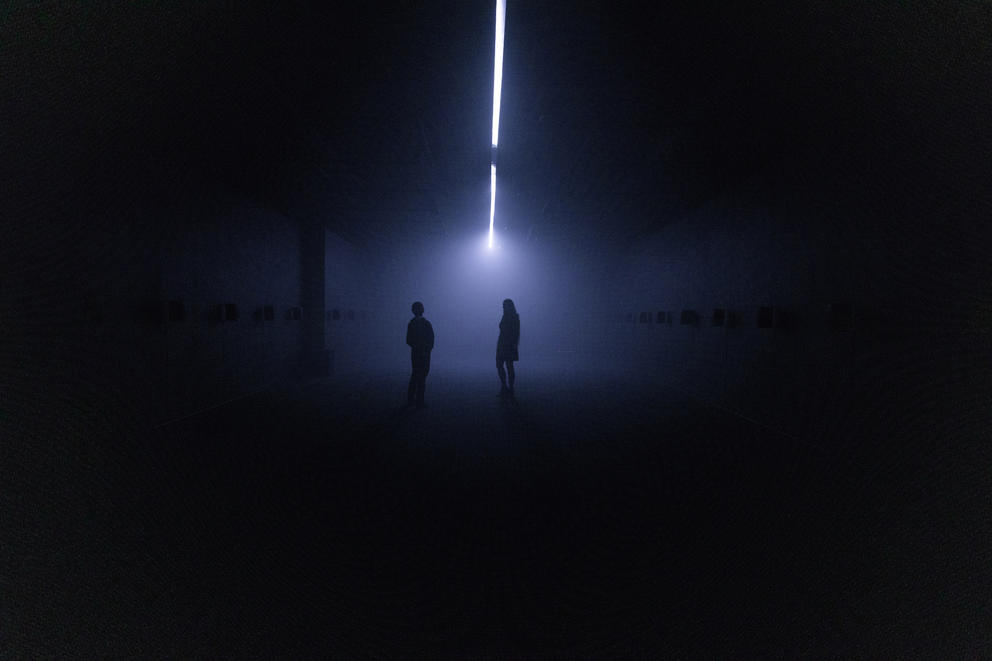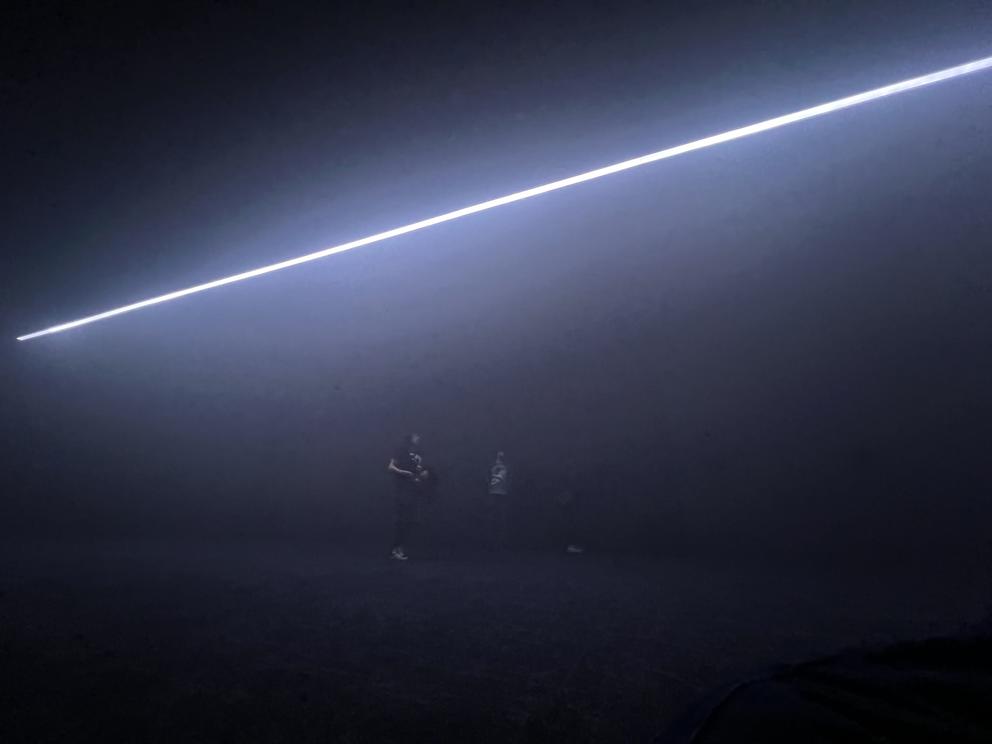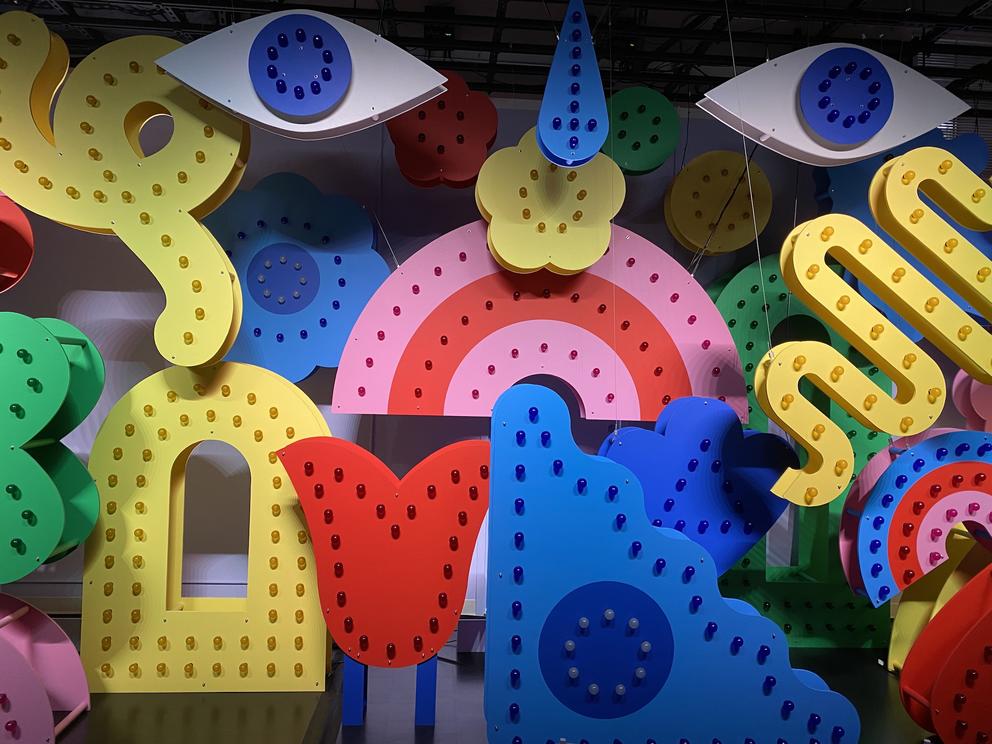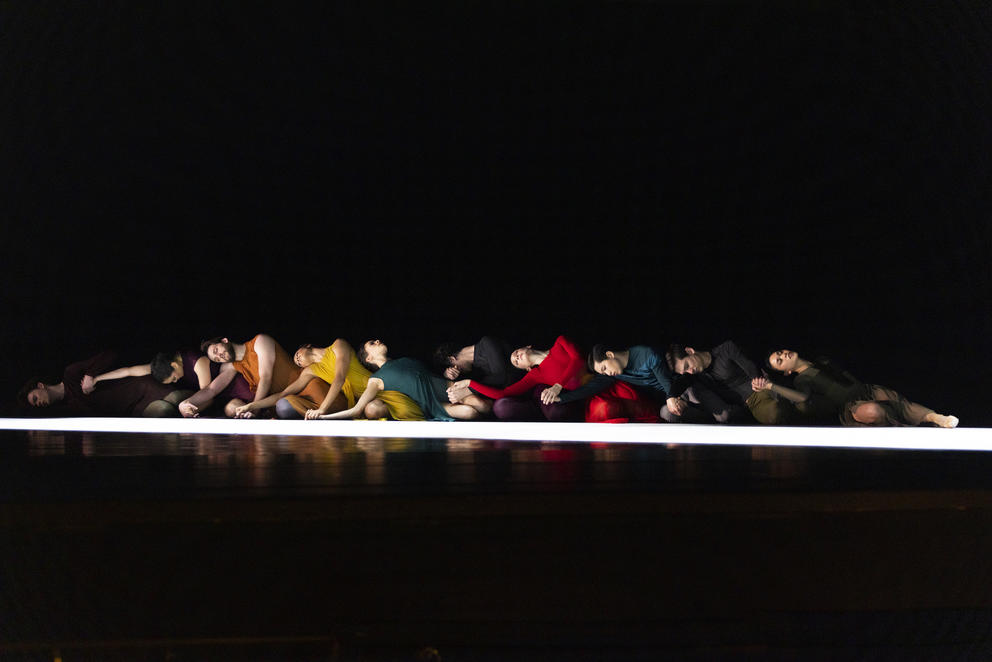FLØÐ (Flood) is the newest installation by Sigur Rós lead singer and guitarist Jónsi (Jón Þór Birgisson), who designed the piece site-specifically for the National Nordic Museum, where it runs through July 30.
ArtSEA: Notes on Northwest Culture is Crosscut’s weekly arts & culture newsletter.
The Icelandic L.A.-based artist — known for his angelic vocals and for singing in an invented language called “Hopelandic” — has in recent years expanded from packing concert halls with ambient music to creating intimate, immersive art-sound-and-scent experiences.
All of Jónsi’s artworks have an environmental focus, whether subjecting viewers to an active volcano or the glare of sun flares or whiteout conditions. The idea is to represent the immense forces of nature, giving people a sense of comparative smallness and also a glimpse of the sublime.
In FLØÐ, the environmental parallel is rising sea levels, or, as he told me with a smile in an interview at the museum, “the big wave that is going to drown us all.”
Throughout the 25-minute cycle of sound, sights and scent, the landing strip of ceiling light shifted from darkened to flickering, from lava-lamp blobs to solid white. When I entered, it was lit only for seconds at a time, leading to my sudden, late realization that other people were in the room with me.
Up ahead in the haze I saw flashes of human forms — flattened against the walls and carpet like seaweed against rocks. (Adding to my disorientation, someone at the far end of the space was doing a downward dog.)
“It’s supposed to be a void,” an installer on a scissor lift had shouted down to me the day before. At that point, the gallery was well-lit and looked like nothing more than a black-walled conference room with an excess of speakers mounted at eye level. But the next day it was transformed; the void emerged.
“This is what it might smell like when there’s nothing left but seaweed and maybe some burnt wood,” Jónsi told me about his choice of scent, adding, “Very uplifting.” Though his installation is apocalyptic, he maintains a sense of humor — evident too in the exhibit-affiliated candles and incense available in the gift shop.
Part of his family’s perfumery line Fischersund, several of the scents have lavish descriptive text written by Jónsi, such as for No. 23: “Smoke in the air and tarred telephone poles … Dead flowers bow to the ground … A beached whale is about to explode.” (Surprisingly appealing to the nose.)
FLØÐ is awash in anticipation of the unknown, heightened by some 40 carefully calibrated speakers and subwoofers that project the sound of a wave crashing down the long room. Jónsi combined oceanic field recordings with clicking, popping and whooshing sounds to expand the effect. And when his ethereal vocals kick in, so do delight and wonder, a feeling of being nowhere and everywhere at once, of moving from flooded to floating.
A few days after diving into the transportive FLØÐ installation, I visited another immersive experience: the newly opened WNDR Museum on Alaskan Way. Pronounced “wonder,” the permanent museum is the local outlet of a concept originally launched as a pop-up in Chicago in 2018. (San Diego has another iteration and Boston is getting one soon.)
Billed as “Art + Tech + You,” the space contains about 20 exhibits — most of them clearly designed to produce an awesome Instagram photo. We’ve seen a proliferation of such spaces recently, from the art-history-inflected Van Gogh: The Immersive Experience to the blatant Seattle Selfie Museum.
When I asked Jónsi whether his piece fit into this trend, he acknowledged the connection but noted, “It’s not really Instagram-friendly. It’s very dark.”
At the WNDR Museum, signs and gift-shop T-shirts insist “We Are All Artists,” which is hard to argue with, yet seems to aggressively encourage a flattening-out of skill levels. Must we all consider ourselves artists? Could some of us just enjoy the work of those who are really good at it?
One of the most prominent artists on view here is the legendary Yayoi Kusama — goddess of infinity rooms. I was reminded of her work while inside Jónsi’s installation, in the way the room seemed to lose its edges and stretch on forever. Sadly, we don’t get one of Kusama’s mirrored infinity rooms here, but you can see one of her gigantic mosaic pumpkins, perched in a corner.
“You Can Do Most Anything,” a fun interactive piece by Seattle- and Tulsa-based artist Andy Arkely, encourages viewers to push a button panel that lights up a series of colorful shapes and creates unique musical patterns. And with “INSIDEOUT,” Scottish-born Berlin artist Leigh Sachwitz invites visitors to experience a calming digital rain shower and sunrise while sitting inside a transparent garden shed.
There’s a motion-activated hallway with cascading lights. There’s an AI feature that creates digital art based on your suggestions (it didn’t seem too familiar with the work of Antoni Gaudí). There’s a mirrored room with a digital projection of a robot hand holding a human heart.
The whole thing has more of an arcade vibe than of an art museum. And maybe that’s fine. Kids especially will probably love WNDR, and who knows, maybe one of them will be inspired to become an artist. There’s nothing particularly wrong about positioning art in this pop-tech fashion — but it does make me wndr.
For those looking to immerse themselves in old-fashioned art forms this weekend, I have recommendations:
• Illustrious Seattle jazz trombonist Julian Priester presents “Julian Speaks,” in which he’ll share memories from his decades of performance history, including his time touring with Duke Ellington and Herbie Hancock. (Langston Hughes Performing Arts Institute, March 25, 1 p.m.)
• Pacific Northwest Ballet brings on the second weekend of Boundless (March 23 - 26; streaming March 30 – April 3), a beautiful mixed bill of contemporary work by Penny Saunders, Alejandro Cerrudo and Jessica Lang — the last of which is especially lovely, with costumes that bring the ROYGBIV spectrum to fluid life.
• Ikat: A World of Compelling Cloth (at Seattle Art Museum through May 29) presents a tantalizing array of textiles. Arranged by region of origin, this gorgeous collection showcases painstakingly knotted and dyed garments and tapestries from Japan, Nigeria, India, Uzbekistan and elsewhere.
And while it’s very hard to refrain from reaching out and running your hand across these fabrics, this is one exhibit where full immersion is off limits.
Get the latest in local arts and culture
This weekly newsletter brings arts news and cultural events straight to your inbox.






